|
 Hygrocybe striatolutea Hygrocybe striatolutea
BiostatusPresent in region - Indigenous. Endemic
Images (click to enlarge)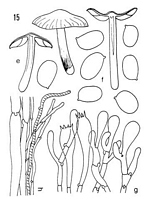
Caption: Hygrocybe striatolutea Hk. (type):e. carpophores. - f. spores. - g. basidia and cheilocystidia. - h. cuticle | 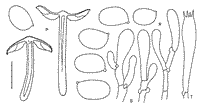
Caption: Fig. 13 Hygrocybe striatolutea Horak (P-T: PDD 27081, type):
P. basidiomes. R. spores. S. cheilocystidia T. basidium. | 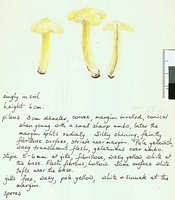
Caption: Watercolour
Owner: G.M. Taylor | 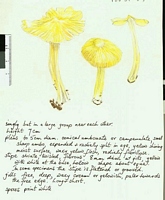
Caption: Watercolour
Owner: G.M. Taylor | 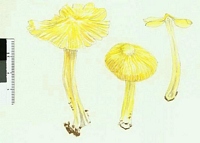
Owner: G.M. Taylor | 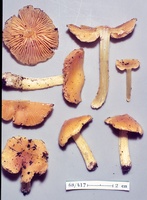
Caption: ZT68-417 , Holotype
Owner: E. Horak: © Creative Commons Attribution-Noncommercial 3.0 New Zealand | 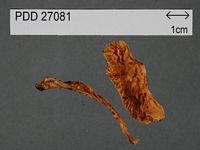
Caption: Dried type specimen
Owner: Herb PDD |
Article: Horak, E. (1990). Monograph of the New Zealand Hygrophoraceae (Agaricales). New Zealand Journal of Botany 28(3): 255-306 (http://www.rsnz.org/publish/abstracts.php).
Description: Pileus -50 mm, convex later becoming umbonate-convex or depressed with distinct
conical or obtuse umbo; golden yellow to brilliant yellow, fading towards margin;
glutinous to viscid, glabrous, hygrophanous, striate margin often splitting.
- Lamellae crowded, adnexed to almost free, ventricose; yellow to pale orange
yellow, edges concolorous or grey from gelatinous thread. - Stipe 35-60 x 5-7
mm, cylindrical, equal; concolorous with pileus or paler, whitish grey towards
base; viscid in wet condition, dry becoming longitudinally fibrillose, hollow,
fragile, single. - Context yellow, in pileus with orange tint, not blackening.
- Odour and taste not distinctive. - Chemical reactions on pileus: KOH and HCl
- negative.
Spores 9-11 x 6-7 um, ovoid. - Basidia 40-52 x 10-13 um, 4-spored. - Cheilocystidia
articulate, terminal cells cylindrical to clavate (2~40 x 312 1lm), membrane
hyaline, strongly gelatinised. - Pleurocystidia absent. - Pileipellis an ixocutis
of cylindrical, strongly gelatinised hyphae (3-10 um diam.), with yellow (KOH)
plasmatic pigment; clamp connections present (Pl. 1, Fig. 7).
Habitat: ECOLOGY: Rare; saprobic on soil among litter in broadleaved-conifer forests
(Meterosideros, Elaeocarpus, Dodonaea, Dacrydium, Rhopalostylis). May.
Distribution: DISTRIBUTION: NZ (NA,N).
Article: Horak, E. (1973). Fungi Agaricini Novazelandiae I-V. Beihefte zur Nova Hedwigia 43: 200 p.
Description: Pileus 25-50 mm diam., convex when young later becoming convex-umbonate or umbonate-depressed, umbo always distinct, golden yellow to deep yellow, fading towards the striated margin, radially splitting, membranaceous, glutinous, glabrous. Lamellae adnexed or almost free, ventricose, yellow or light orange-yellow, gill edge with grey gelatinous thread. Stipe 35-60 x 5-7 mm, cylindric, concolorous with pileus or paler, whitish-grey towards the base, viscid, longitudinally fibrillose, hollow, single. Context orange-yellow in pileus, otherwise yellow, not blackening. Taste and odor not distinctive. Chemical reactions on pileus: KOH and HCl - negative.
Spores 9-l1 x 6-7 µm, ovoid, smooth, inamyloid. Basidia 42-52 x 10-13 µm, 4-spored. Cheilocystidia of articulate cells, membrane strongly gelatinized, forming the gelatinous thread on the gill edge. Cuticle of repent or suberect, hyaline gelatinized hyphae forming a cutis, plasmatic pigment present. Clamp connections numerous.
Habitat: In soil under broadleaf trees (Metrosideros, Elaeocarpus, Dodonaea, Rhopalostylis, etc.). New Zealand.
Notes: This species is characterized chiefly by its glutinous pileus and stipe and the spores which are considerably larger than those reported for the related European species H. ceracea (Fr.).
|